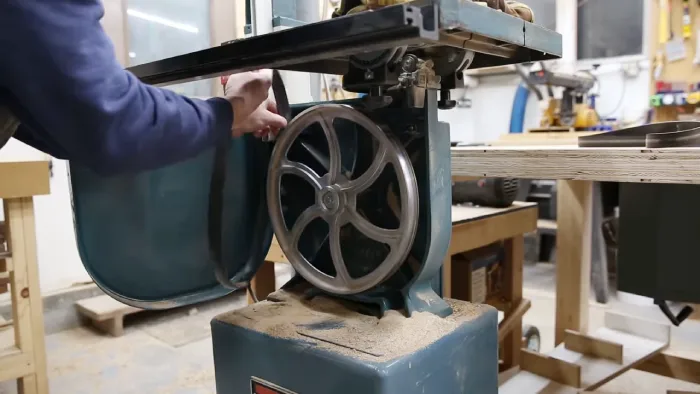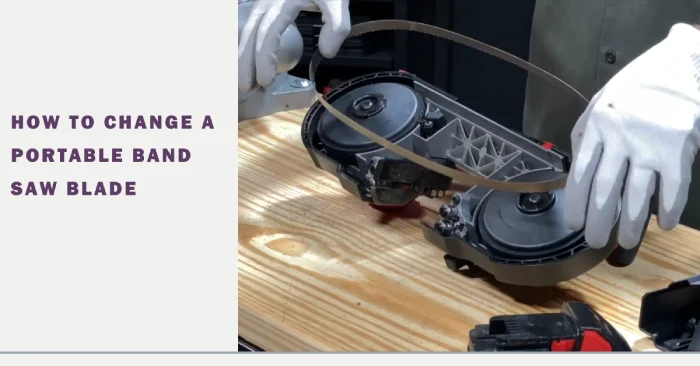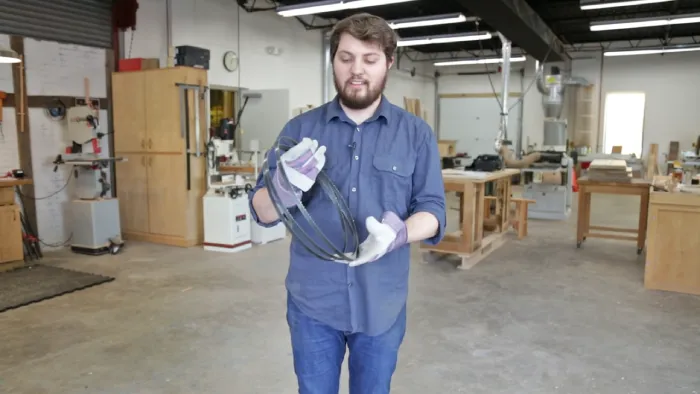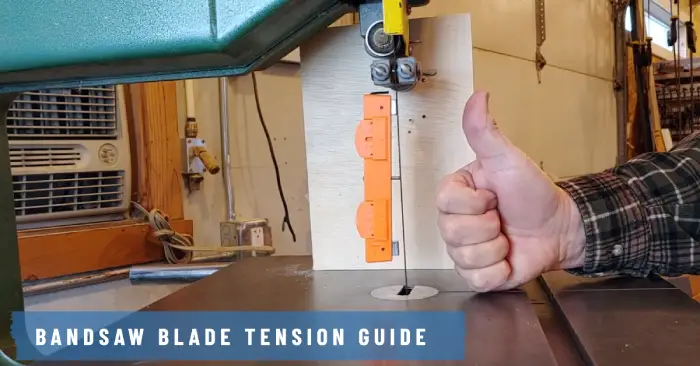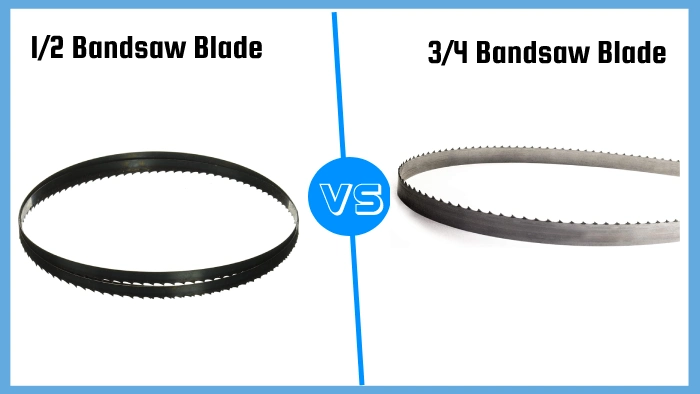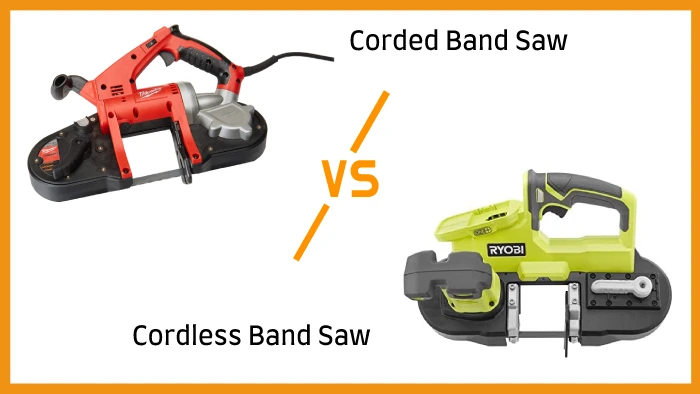Why Is My Bandsaw Vibrating: Behind the Reasons
A bandsaw is a versatile and indispensable tool in woodworking and metalworking, prized for its precision and efficiency. However, bandsaw vibrations can significantly impact its performance, leading to compromised cuts and a less-than-optimal working experience.
According to my findings, first check the blade tension, as improper tension can lead to vibrations. Tire misalignment can also be a culprit, so inspect the tires for any irregularities.
Also, blade alignment problems, blade condition and sharpness, and wheel balance should be examined since these factors can contribute to vibrations.
Here, I will dive deeper into each of these reasons and provide solutions to help you restore precision in your bandsaw projects.
Why Is My Bandsaw Vibrating: 8 Causes and Solutions

As far as I know, woodcutting bandsaw blades should operate smoothly without any shaking or vibrating. However, the following factors can cause this issue:
- Blade tension issues
- Tire misalignment
- Blade alignment problems
- Blade condition and sharpness
- Wheel balance
- Guide bearing and roller issues
- Motor or pulley problems
- Workpiece stability
No 01: Blade Tension Issues
Harmonic vibrations can occur when the tension levels are incorrect, whether too high or too low. This can lead to blade flutter, characterized by side-to-side oscillation and a wider blade appearance.
It’s crucial to adjust the tension to the manufacturer’s specifications to eliminate this issue and maintain stable cutting performance. By doing so, you can ensure that the blade is properly tensioned and minimize vibrations.
I advise you to note that different blades may require different tension levels, so consult the bandsaw’s manual or the manufacturer’s guidelines.
No 02: Tire Misalignment
To address another potential cause of vibrations in your woodworking bandsaw, let’s now turn our attention to the issue of tire misalignment.
Misalignment of the bandsaw tire, particularly with a urethane tire, can contribute to vibrations. If the tire isn’t evenly aligned on the wheel, visible oscillation may be observed from the side of the blade. This misalignment leads to instability during operation, resulting in unwanted vibrations.
Ensuring the bandsaw tire size is aligned properly on the wheel is essential for minimizing this vibration source. Regularly inspect the tire to ensure it’s securely and evenly seated on the wheel.
If misalignment is detected, adjust the tire accordingly to reduce vibrations and improve the overall performance of your bandsaw.
No 03: Blade Alignment Problems
Another potential cause could be blade alignment problems. Proper blade alignment is crucial for smooth and accurate cuts. If the blade isn’t aligned correctly with the guides, it can cause lateral movement and vibrations.
To ensure optimal performance, regularly check and adjust the blade alignment. Start by checking the guides and ensuring they’re positioned correctly and tightened securely. If the blade isn’t centered within the guides, adjust them accordingly.
Additionally, inspect the rollers to ensure they’re in good condition and properly aligned with the blade. By addressing blade alignment problems, you can eliminate vibrations and achieve precise cuts with your woodworking bandsaw.
No 04: Blade Condition and Sharpness
If you want to address the vibrations in your woodworking bandsaw, I believe another crucial aspect to consider is the condition and sharpness of the blade. The condition of the bandsaw blade plays a significant role in vibration.
A blade with a bad weld or uneven blade back can cause consistent changes in proximity to the thrust bearing, resulting in periodic ticking sounds and vibrations. Regularly inspecting the blade for any faults and ensuring it’s sharp and in good condition is essential for minimizing vibration during cutting operations.
A dull blade can also lead to vibrations as it requires more force to cut through the material, causing it to flex and vibrate. Therefore, maintaining a sharp blade is vital for reducing vibrations and achieving smoother cuts.
No 05: Wheel Balance
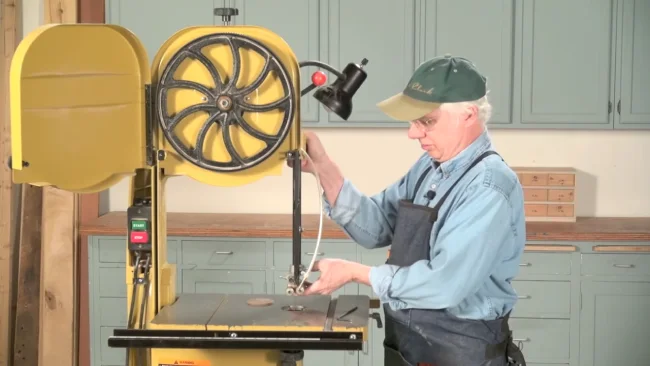
The balance of the wheels plays a crucial role in minimizing vibrations in your woodworking bandsaw. Non-round or off-center wheels can contribute to vibrations that affect the performance and accuracy of your saw. Make sure that the tires on the wheels are evenly stretched to maintain consistent blade tension.
You should check for pitch changes while turning the wheels to identify wheel-related vibrations. Precise balancing of the wheels is crucial for reducing vibrations, even if it requires adding weight to achieve the proper balance.
No 06: Guide Bearing and Roller Issues
To minimize vibrations in your woodworking bandsaw, it’s crucial to address guide-bearing and roller issues.
The guides must be correctly positioned and tightened to prevent lateral movement of the blade. Worn or damaged guide bearings can result in instability and vibrations during cutting. Regular maintenance and replacement of worn components are essential for ensuring smooth operation and minimizing vibrations.
When inspecting the guide bearings, check for any signs of wear or damage such as excessive play or rough movement. If any issues are detected, replace the bearings with new ones compatible with your bandsaw model.
Additionally, make sure that the rollers are clean and free from debris, as buildup can cause uneven movement and contribute to vibrations.
No 07: Motor or Pulley Problems
Now let’s shift our focus to addressing motor or pulley problems, which can be another factor contributing to vibrations in your woodworking bandsaw.
Motor-related factors, such as an unstable motor mount, can cause the motor to shake, resulting in overall machine vibrations. It’s important to ensure the motor mount is rigid and stable to minimize vibrations.
Problems with the pulleys can also introduce vibrations, especially if the V-belt runs unevenly. To address this, I recommend ensuring the pulleys are functioning properly and the V-belt is running smoothly.
No 08: Workpiece Stability
Workpiece stability is also crucial in minimizing vibrations and ensuring accurate and smooth cuts on your woodworking bandsaw.
When the workpiece isn’t securely held in place or if the material being cut is prone to movement, it can induce vibrations in the bandsaw. These vibrations can lead to inaccurate cuts and rough surfaces.
To ensure proper workpiece stability, it’s important to use appropriate clamps or fixtures to hold the material in place securely. Using a larger work surface or adding additional support under the workpiece can also help minimize vibrations.
How does the choice of motor impact bandsaw vibrations?
The choice of motor for a bandsaw significantly impacts the level of vibrations experienced during woodworking operations. When selecting a motor for your bandsaw, I recommend considering the motor speed and pulley size.
Opting for a slower motor with a larger pulley, typically operating at 1750 RPM, is recommended. This choice reduces noise and vibrations and increases the efficiency of the V-belt. Utilizing a larger pulley, the V-belt experienced less strain, resulting in smoother operation and minimized vibrations.
Regarding motor speed, slower motors are preferred as they reduce the likelihood of excessive vibrations. Higher motor speeds can cause the bandsaw blade to vibrate excessively, leading to inaccurate cuts and a rough finish on the workpiece.
Can using different blade sizes on my bandsaw contribute to vibrations?

As per my research, different blade sizes on your bandsaw can contribute to vibrations, even if they’re new. The bandsaw’s setup and tensioning requirements may vary for different blade sizes.
Using a blade that’s larger or smaller than the one recommended for your bandsaw can affect the balance and stability of the machine, leading to vibrations during operation. Blade size affects the tension required to keep the blade properly aligned and in place.
If the tension isn’t set correctly, the blade may not track correctly, causing it to wander and vibrate. Additionally, the gullet size, tooth pitch, and overall width of the blade can impact how it cuts through the material, contributing to vibrations.
Do Good Quality Band Saws Have Less Vibration?
As a woodworking enthusiast, I can attest that good-quality band saws are designed and built with features that help minimize vibrations. These band saws often incorporate robust construction, precision engineering, and advanced components.
Higher quality materials and craftsmanship contribute to improved balance, stability, and overall performance. In addition to vibration-dampening features, these band saws may have well-engineered wheel systems, effective blade tensioning mechanisms, and sturdy stands.
While you may be hesitant to spend more than usual on a bandsaw, the benefits of doing so are well worth it. And if you’re in the market for a quality bandsaw without breaking the bank, our article on the bandsaw under 1000 is a must-read.
Making Sense of the Symphony of Bandsaw Vibrations
As you can see, bandsaw vibrations are multifaceted, affecting factors such as blade tension, tire misalignment, motor choice, and workpiece stability. By diligently addressing each potential source of vibration, you can enhance the longevity of your bandsaw and elevate the quality of your craftsmanship.
I believe that this journey into the intricacies of bandsaw vibrations will empower users to navigate the challenges and harness the true potential of this essential tool.
With this knowledge, wood and metal workers alike can confidently embark on their cutting endeavors. The vibrations will be controlled, allowing the bandsaw to hum precisely and efficiently.

